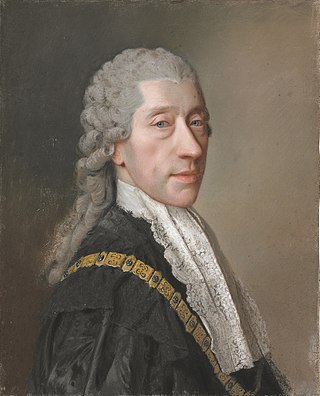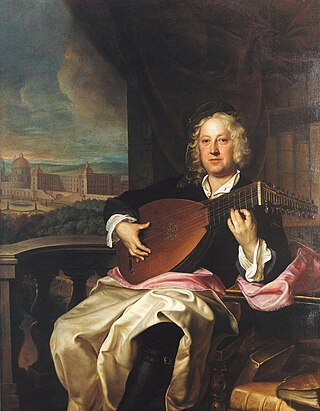
Klemens Wenzel Nepomuk Lothar, Prince of Metternich-Winneburg zu Beilstein, known as Klemens von Metternich or Prince Metternich, was a conservative Austrian statesman and diplomat who was at the center of the European balance of power known as the Concert of Europe for three decades as the Austrian Empire's foreign minister from 1809 and Chancellor from 1821 until the liberal Revolutions of 1848 forced his resignation.

Hans-Adam II is the reigning Prince of Liechtenstein, since 1989. He is the son of Prince Franz Joseph II and his wife, Countess Georgina von Wilczek. He also bears the titles Duke of Troppau and Jägerndorf, and Count of Rietberg. Under his reign, a 2003 constitutional referendum expanded the powers of the Prince of Liechtenstein. In 2004, Hans-Adam transferred day-to-day governmental duties to his eldest son Hereditary Prince Alois as regent, like his father had granted him in 1984 to prepare him for the role.

Johann Philipp, Graf von Cobenzl was a statesman of the Habsburg monarchy and the Austrian Empire.
Prince Constantin of Liechtenstein, known professionally as Constantin Liechtenstein, is a member of the Princely House of Liechtenstein, and a businessman. He is the third son of Prince Hans-Adam II and his wife, Countess Marie Kinsky of Wchinitz and Tettau. He is the chief executive officer of the Liechtenstein Group.

Rietberg is a town in the district of Gütersloh in the state of North Rhine-Westphalia, Germany. It is located approximately 10 km south of Gütersloh and 25 km north-west of Paderborn in the region Ostwestfalen-Lippe. The town is located at the river Ems. There are 28,878 people living in Rietberg.

Verl is a town in the district of Gütersloh in the state of North Rhine-Westphalia, Germany. It is approximately 15 km south of Bielefeld and 10 km east of Gütersloh.

The House of Sinzendorf was a German noble family with Upper Austrian origin, not to be confused with the Lower Austrian House of Zinzendorf. The family belonged to prestigious circle of high nobility families, but died out in 1822 in the male line.

The County of Rietberg was a state of the Holy Roman Empire, located in the present-day German state of North Rhine-Westphalia. It was situated on the upper Ems in Westphalia, between the Prince-Bishopric of Paderborn and the Prince-Bishopric of Münster. It existed as an independent territory from 1237 to 1807, when it was mediatised to the Kingdom of Westphalia.

The Imperial and Royal Foreign Ministry was the ministry responsible for the foreign relations of the Austro-Hungarian Empire from the formation of the Dual Monarchy in 1867 until it was dissolved in 1918.

In Austrian politics, the Federal Chancellery is the ministry led by the chancellor. Since the establishment of the First Austrian Republic in 1918, the Chancellery building has served as the venue for the sessions of the Austrian cabinet. It is located on the Ballhausplatz in the centre of Vienna, vis-à-vis the Hofburg Imperial Palace. Like Downing Street, Quai d'Orsay or – formerly – Wilhelmstrasse, the address has become a synecdoche for governmental power.

Wenzel Anton, Prince of Kaunitz-Rietberg was an Austrian and Czech diplomat and statesman in the Habsburg monarchy. A proponent of enlightened absolutism, he held the office of State Chancellor for about four decades and was responsible for the foreign policies during the reigns of Maria Theresa, Joseph II, and Leopold II. In 1764, he was elevated to the noble rank of a Prince of the Holy Roman Empire (Reichfürst).

Franz Wenzel, Graf von Kaunitz-Rietberg was an Austrian general who saw service in the Seven Years' War and Wars of the French Revolution.

Balogh von Mankobük or Balog de Manko Bückin its present Germanized form, mankóbükiBalogh in Hungarian, was a Austro-Hungarian noble family from the Habsburg monarchy, originally from the region of Sopron / Ödenburg.

Count Maximilian Ulrich von Kaunitz-Rietberg was an Austrian diplomat and politician who served as governor of Moravia from 1720 until his death. He was the father of the powerful state chancellor of Maria Theresa, Holy Roman Empress and Queen Regnant of Bohemia and Hungary, Wenzel Anton, Prince of Kaunitz-Rietberg.

Georg Decker was an Austro-Hungarian portrait artist.

The Palais Kaunitz-Wittgenstein is a Baroque palace built in 1703 in Laxenburg, Lower Austria. Initially used as a summer residence, the palace also served as a museum, an educational institute, and a community center. Since 2010 the palace is the headquarters of the International Anti-Corruption Academy (IACA).

Joseph Pichler was an Austrian painter, best known for his frescoes.
The Kaiserlich-königliche Akademie für Orientalische Sprachen, also known as the Oriental Academy) was founded in 1754 by Empress Maria Theresa in Vienna.

Count Johann Adam von Questenberg was an Austrian nobleman, Reichshofrat, amateur musician, and patron of the arts. He was a councilor of the Imperial Court in Vienna from 1702 to 1735. He organised concerts at his palaces in Vienna and Jarmeritz, and commissioned compositions by contemporary composers. He made his palace a music centre of Central Europe.
Sebastiano Ayala was an Italian Jesuit, philosopher and diplomat.

















